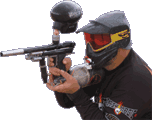  |
|
|
|
|
|
|
  |
|
|
|
|
|
|
|
Interesting...(long response)
In Reply to: I'd like to argue a few points.... posted by Vampyr on June 04, 2003 at 21:44:07:
|
|
Posted by: BodyByHostess on June 06, 2003 at 12:36:14
|
No intent to be argumentative here, but what you're saying is quite different from what I've been doing (the 'Ravi method') :) There seems to be one fundamental difference, and it may be in order to maximize ROF, but it does not make intuitive sense to me. So, unless I misunderstood what you were saying: It seems that the main difference in our approaches is I set my back block such that it is at rest at the max forward limit of the ram. Thus the back limit of my stroke is where the hammer/mainspring 'bottom out'. This is before the maximum ram extension and so, the bolt's rearward travel is set by the length of the cocking rod. From your description, and the comment that the bolt position is set by the pump arm, it would seem your goal is to set the rearward travel of the bolt at the maximum extension of the ram (before the hammer/mainspring bottom out). This would result in the back block being at rest prior to the forward limit of the ram. The conventional thinking is that the part of the ram's travel that is the weakest, is at either of it's limits. Thus, setting the back block & cocking rod as I described allow the ram to compress the main spring when the ram is stronger rather than at it's maximum extension (weaker part of the stroke). Your method forces the ram to use it's maximum extension at the very point when it needs the greatest force. On the other end of the stroke, my (Ravi's) method uses the ram's weakest part of the stroke when it is only moving the back block and bolt, rather than compressing a spring. Your method would have the ram doing this at it's strongest. Additionally, by not allowing the ram to reach it's full forward stroke, the back block would slam into the back of the body with each cycle. It also is interesting to me that you say that having the bolt travel as much as 1/4 inch past the breach is a good thing. I would assume that for the fastest cycling, any unnecessary movement of the back block & bolt should be eliminated. So, either I misunderstood some of the things you were saying, or my assumptions about ram power being greatest during the middle of the stroke are incorrect. But, if I didn''t misunderstand, and if I'm correct about the ram stroke, then I'm convinced that the 'Ravi method' is still the best :) |
Follow Ups:
|
| Copyright © 1992-2019
Corinthian Media Services. WARPIG's webmasters can be reached through our feedback form. All articles and images are copyrighted and may not be redistributed without the written permission of their original creators and Corinthian Media Services. The WARPIG paintball page is a collection of information and pointers to sources from around the internet and other locations. As such, Corinthian Media Services makes no claims to the trustworthiness or reliability of said information. The information contained in, and referenced by WARPIG, should not be used as a substitute for safety information from trained professionals in the paintball industry. |